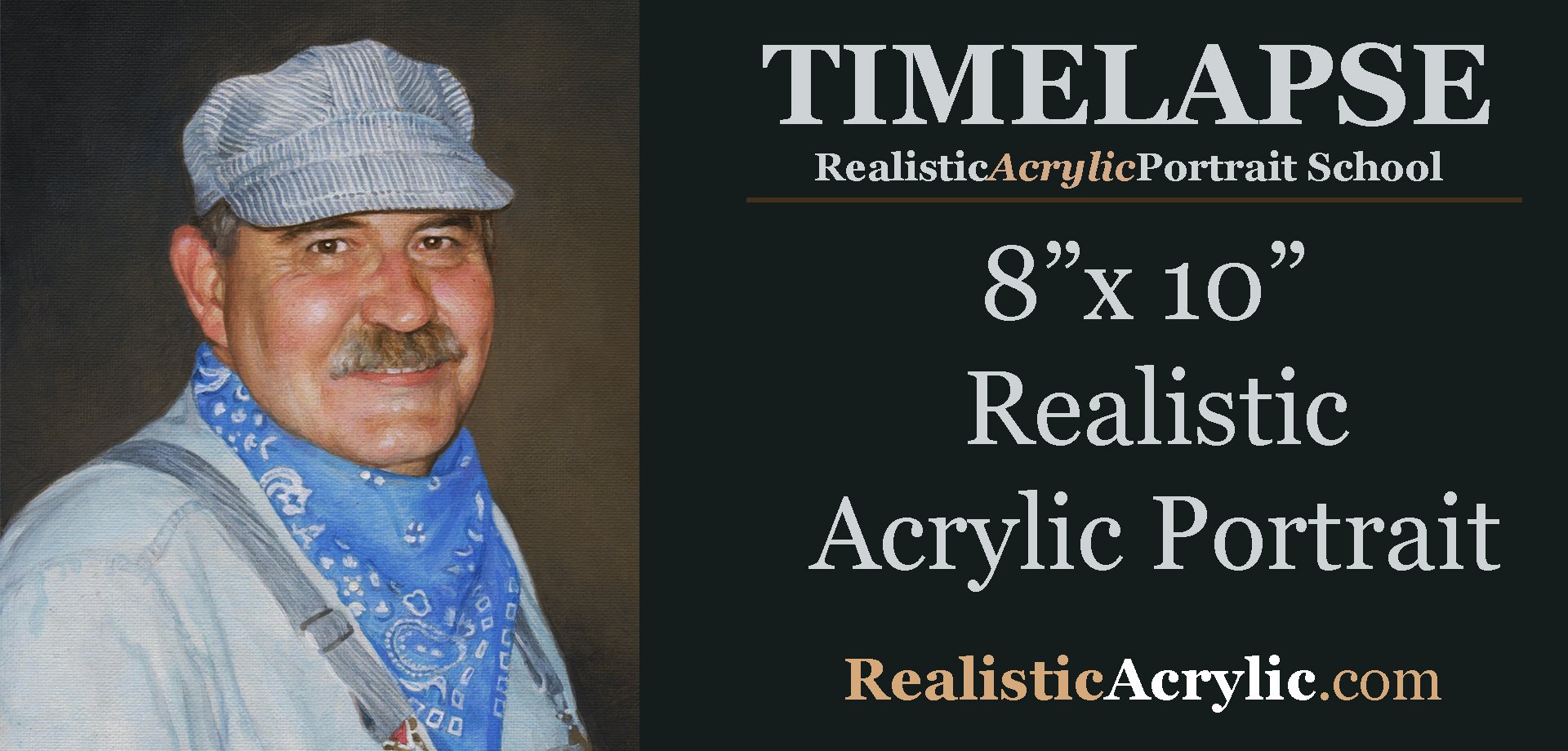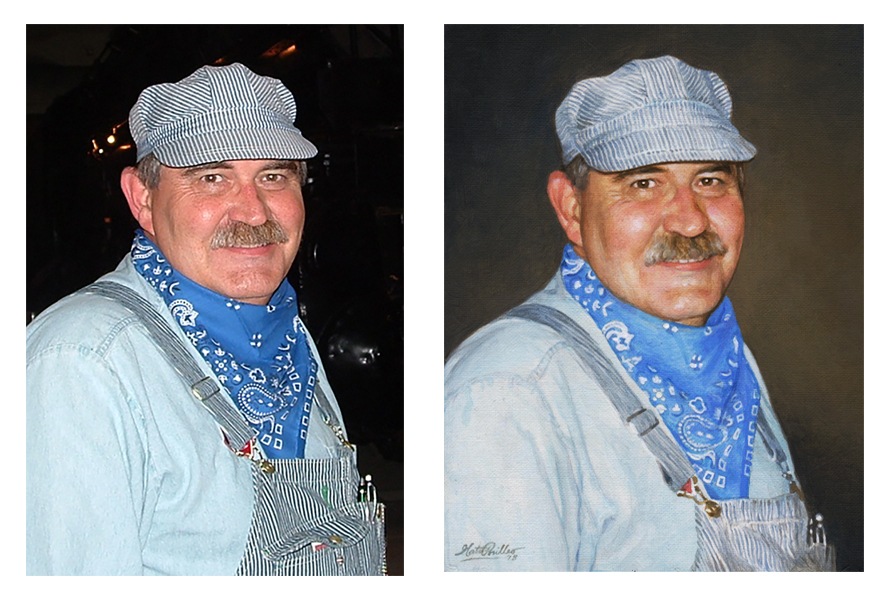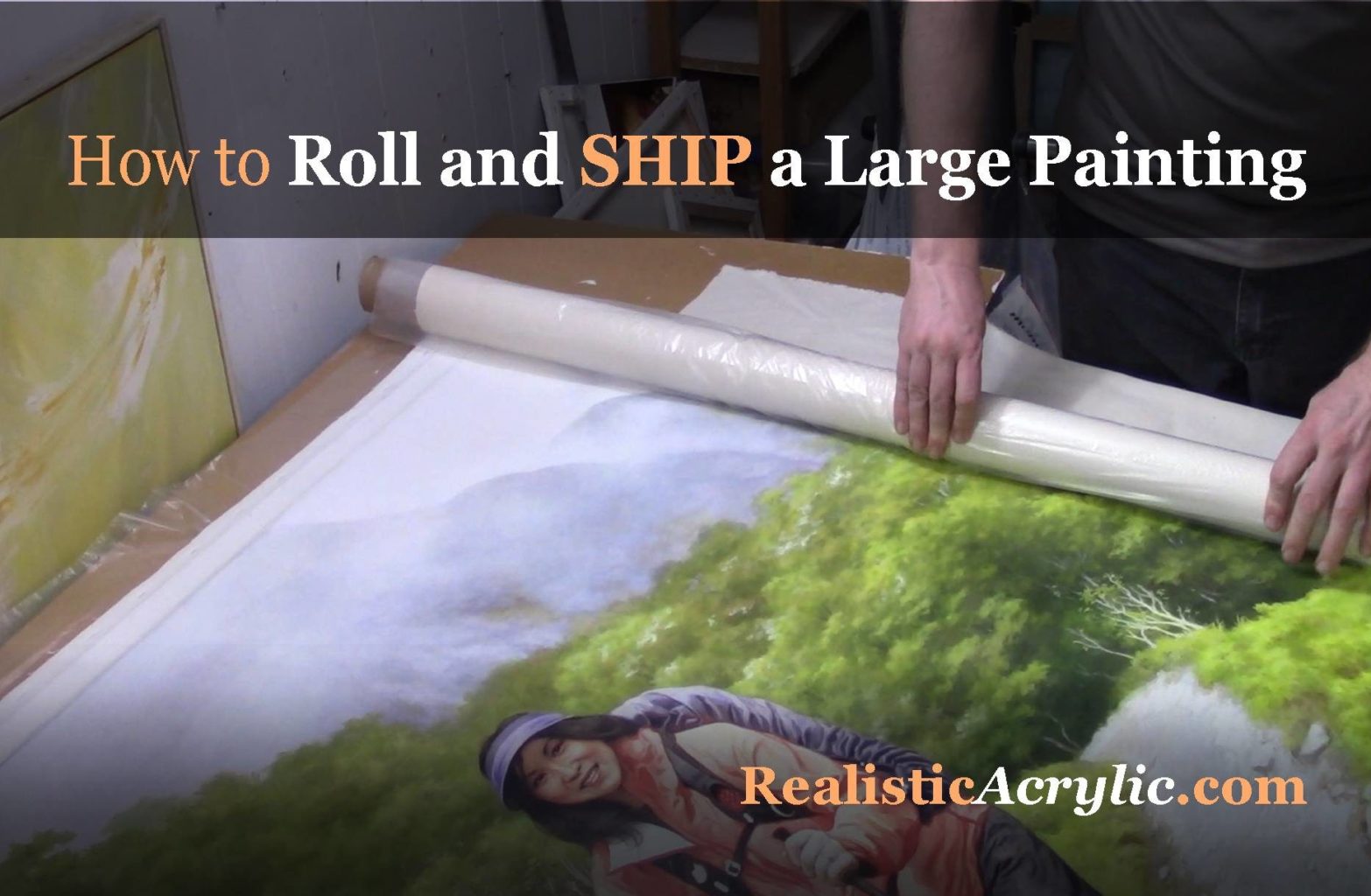Archive Monthly Archives: December 2018

How to Paint 8 x 10 Realistic Acrylic Portrait Timelapse
Just prior to Christmas, I finished this portrait of a local engineer.
Creating a realistic acrylic portrait can be a rewarding experience, especially when utilizing the glazing technique. This method involves layering transparent paints to build depth and luminosity in your artwork. In this tutorial, a step-by-step guide is provided to help artists of all levels achieve impressive results in an 8 x 10 portrait.

Understanding the Glazing Technique
The glazing technique is foundational in creating depth and realism in acrylic painting. It is characterized by the application of thin, transparent layers of color, allowing the underlying layers to shine through. This method is often compared to photography, where an image starts light and gradually gains depth.
Materials Required
Before beginning, ensure that the following materials are prepared:
- Acrylic paints: Ultramarine blue, brownish tone (raw umber or dark), and skin tones
- Clear acrylic matte medium
- Brushes: Small round brushes, flat brushes, and a small detail brush
- Palette for mixing colors
- Canvas (8 x 10 inches recommended)
- Water for rinsing brushes
Step-by-Step Process
Step 1: Preparing the Background
To commence, a light glaze is applied to the background using clear acrylic matte medium. This initial layer serves as a foundation for subsequent colors and adds a soft, ethereal quality to the painting.
Step 2: Adding Foreground Details
Once the background is set, the first layer of details can be added. Ultramarine blue is used to paint the hat, while the brownish tone is applied to create depth in the background. Care is taken to let these layers dry before continuing with additional details.
Step 3: Building Up Layers
The glazing technique thrives on layering. After the initial foreground details have dried, the focus shifts to the face and scarf. By layering thin glazes, the desired colors are built up gradually, allowing the light to penetrate through the layers.
- Tip: Work from foreground to background to maintain focus on the subject. This approach helps keep details sharp and defined.
Step 4: Detailing the Features
Attention is drawn to the finer details in the face, such as the eyes and lips. Using various skin tones, nuances are added to create dimension. This is achieved by carefully layering pinkish tones on the cheeks and around the eyes, emphasizing features like eyebrows and the mustache with darker shades.
- Technique: When applying glazes, it is essential to work thinly. The use of a clear acrylic medium mixed with paint ensures translucency, allowing for subtle color variations.
Step 5: Refining and Smoothing
As the painting progresses, the need to refine details becomes evident. Skip around the canvas, working on different sections to ensure balance and harmony in the overall composition. Smoothing out areas with a gentle hand helps in creating a realistic appearance.
- Tip: Varying brush sizes and techniques can significantly enhance texture. Larger brushes are suitable for broader areas, while smaller brushes are ideal for intricate details.
Step 6: Enhancing Realism
To achieve a realistic finish, darker tones are added under the chin and in shadowed areas, enhancing the sense of depth. Highlights are strategically placed to simulate the effect of light on the face and clothing.
- Technique: As the final layers are applied, incorporating more opaque white paint helps achieve smoother transitions between colors.
Step 7: Final Touches
At the later stages of the painting, I continue to add details and shading. Varying line thickness and texture are key components to realism. Then moves back and forth between different areas of the portrait, ensuring that the final touches are cohesive and enhance the overall image.
Step 8: Signing the Artwork
After all the details have been finalized, the painting is signed. This not only signifies the completion of the work but also adds a personal touch to the artwork.
Conclusion
This step-by-step guide on painting a realistic acrylic portrait using the glazing technique showcases how layered approaches can bring an image to life. By utilizing transparency and careful detailing, you can create stunning, lifelike portraits that capture the essence of their subjects.
Whether you are an experienced artist or just starting, mastering the glazing technique will enhance your acrylic painting skills.
Additional Tips and Techniques
- Experiment with Colors: Don’t hesitate to mix different colors to achieve unique skin tones and shades.
- Practice Patience: Building up layers takes time, but the results are worth the effort.
- Use Reference Images: Having a clear reference will guide your color choices and proportions, making the process smoother.
By following these steps, you can enhance your painting techniques and create stunning, realistic portraits. Embrace the glazing method and enjoy the process of bringing your artistic visions to life!
For further resources and guides, visit realisticacrylic.com and check out my free courses to enhance your acrylic painting journey
Would you like to learn how to paint like this, with individual lessons broken down and explained?
Learn How to Paint Acrylic Portraits With My Free Mini-Video Course!(The lessons show me painting a different picture, but the technique is the same. Enjoy! 🙂
LEARN MORE
- How to Paint Foliage Using the Acrylic Glazing Technique
- How to Trace for an Accurate Portrait Sketch
- How to Paint Realistic Eyes in Your Acrylic Portrait
- How to Add Raw Umber Dark & Ultramarine Blue to Your Portrait
- How to Make Your Own Raw Umber Dark
- How to Paint Realistic Trees & Grass in Your Acrylic
- How to Block In Skin Tone Values Using Glazing Technique
- How to Paint Vibrant Reds in Your Acrylic Portrait
- How to Glaze Background Colors & More Acrylic Portrait
- How to Paint White Clothing in Your Acrylic Portrait
- How to Easily Transition from a Sketch to a Painting
- How to Block In Shading & Skin Tones in Your Acrylic
- How to Build Up Color on Acrylic Pet Portrait
- How to Build Up Form on Clothing with Acrylic
- How to Paint Dark Clothing Using Acrylic Glazing Technique
- How to Paint a 24 x 30 Acrylic With 30 People
- How to Do Smooth Shading with Acrylic
- How to Sketch an Acrylic Portrait with a Grid
Read more about how to paint a portrait that you can surely be proud of!
Let me know how this helps.
Yours for better portraits,

P.S. Did you find this post helpful or encouraging? If so, send it on ahead! Let others know with the share buttons below. I’d love to hear your comments. Thank you so much! Also, do you have a question on acrylic portrait painting you’d like answered? Let me know, and I’d be happy to help!

Why These Portraits Won the Contest
It is my privilege every week to judge entries for the Realistic Acrylic Portrait School Facebook Contest.
The best 5-6 images get chosen to be included on the Header Image of our 6,000+ member group. But why do I choose the portraits that make it to the top?
In this brief video, I’ll go over the reasons why I awarded these portraits the prizes they received. I also discuss what could be done to improve them.
You can learn from these tips on what makes for a good portrait and how to improve your own.
Also, if you aren’t currently a member of the Realistic Acrylic Portrait School Facebook group (it’s free to join), you should be! Here’s why…
- Get help on your portrait from myself and fellow artists when you feel stuck.
- Share your artwork with others and get inspired to paint more, by seeing what your fellow artists are doing.
- Enter a portrait into the weekly contest, get your work featured, and win a prize!
Join the Realistic Acrylic Portrait School Facebook Group
See you inside the group! Let me know how these tips help, and of course, if you have any questions.
Yours for better portraits,

P.S. Did you find this post helpful or encouraging? If so, send it on ahead! Let others know with the share buttons below. I’d love to hear your comments. Thank you so much! Also, do you have a question on acrylic portrait painting you’d like answered? Let me know, and I’d be happy to help!

How to Ship a Large Painting in a Tube
A step-by-step guide to safely transporting your large portrait painting
Shipping large painting in a tube can often present unique challenges, especially when it comes to ensuring their safe arrival. Many artists find themselves questioning the best methods to transport their artwork without incurring high shipping costs. This guide will explore how to efficiently ship a large painting in a tube, offering tips and techniques for artists and art enthusiasts alike.
Logistics just isn’t my thing.
Nevertheless, when I finished this 48″ x 72″ portrait, for a client from Brunei (about as far as you can get from Wisconsin!) I knew the shipping could cost a pretty penny.

After calling several shipping companies, the cost was going to be in the thousands! Finally, after a lot of back-and-forth, my client suggested that I remove the painting off the stretcher frame and ship it. I have to admit, I never did this before. I have stretched a rolled canvas for someone, so I figured it was basically the same thing, but in reverse!
Understanding the Challenges of Shipping Large Paintings
Shipping oversized artwork can be daunting. Many artists face exorbitant shipping fees when opting for traditional crating methods. In one instance, shipping quotes for a 48 by 72-inch painting reached the $2,000 to $3,000 range. However, there is a more cost-effective and efficient alternative shipping the painting rolled up in a tube.
Step-by-Step Guide to Shipping a Large Painting in a Tube
1. Prepare Your Canvas
The first step in this process involves carefully removing the canvas from the stretcher bars. The canvas is turned over and placed on a drafting table, ensuring ample workspace. Using a flat-head screwdriver, the screws holding the canvas in place are gently pried out. It is essential to avoid tearing the canvas during this step. This is done by scoring the edges of the canvas with an X-Acto blade, allowing for a careful separation.
Tip: Always start from the corners when removing the canvas. This method mimics the way you would stretch a canvas, ensuring the integrity of the artwork is maintained.
2. Roll the Canvas
Once the canvas is detached, a smaller tube with a diameter of around four inches is chosen to provide rigidity during transport. The canvas is rolled slowly and carefully, ensuring it remains straight throughout the process. A thin piece of plastic can be placed between the canvas and the tube to prevent paint from sticking to itself.
Tip: Rolling the canvas in a protective piece of fabric can add an extra layer of protection against dents or creases during shipping.
3. Secure the Canvas
After rolling, the canvas should be covered with craft paper and securely taped at both ends. The rolled canvas can then be placed inside the tube, which should fit snugly. Bubble wrap can be added for extra cushioning, preventing any movement within the tube during transport.
4. Cap the Ends
To ensure the canvas remains secure during shipping, homemade caps can be created for the ends of the tube. These caps can be fashioned from old paint containers, which can be cut and drilled for string ties. This design not only holds the canvas in place but also allows for easy removal upon arrival.
5. Protect Against Moisture
Applying a layer of varnish to the outside of the tube can provide additional protection against moisture during shipping. This added layer of protection can be crucial, especially when shipping to locations with varying climates.
6. Tape Everything Securely
Once the caps are in place, a cardboard cap can be added to the tube. This cap can be made from corrugated cardboard and attached with packaging tape. It is important to ensure that everything is anchored down securely. Several layers of tape can be wrapped around the tube, providing a solid structure for the shipping process.
Tip: It is often better to use more tape than necessary when securing the package, as it will minimize the risk of any damage during transport.
7. Final Checks
Before heading to the shipping facility, hold up the tube to ensure that nothing is rattling inside. A tight fit will help guarantee that the artwork arrives safely at its destination.
Conclusion
The process of shipping a large painting does not need to be an overwhelming task. By following these steps, artists can save on shipping costs while ensuring their artwork arrives in pristine condition. The experience of successfully shipping a large painting in a tube offers peace of mind, knowing that careful preparation can lead to a successful delivery.
Tips for Successful Shipping:
- Use Quality Materials: Always choose sturdy tubes and protective materials to ensure safety.
- Choose the Right Shipping Service: Research and select a reliable shipping service with experience in handling artwork.
- Label Clearly: Include clear labeling on your package to avoid confusion during trans
For further resources and guides, visit realisticacrylic.com and check out my free courses to enhance your acrylic painting journey. Happy painting.
One thing I didn’t mention in the video was that I purchased plenty of insurance. I definitely recommend it.
Great news: I heard back from my client and the painting arrived safely! I guess that means all five pounds of packaging was worth it!
Let me know how these tips help, and have a blessed day!
LEARN MORE
- How to Paint Foliage Using the Acrylic Glazing Technique
- How to Trace for an Accurate Portrait Sketch
- How to Paint Realistic Eyes in Your Acrylic Portrait
- How to Add Raw Umber Dark & Ultramarine Blue to Your Portrait
- How to Make Your Own Raw Umber Dark
- How to Paint Realistic Trees & Grass in Your Acrylic
- How to Block In Skin Tone Values Using Glazing Technique
- How to Paint Vibrant Reds in Your Acrylic Portrait
- How to Glaze Background Colors & More Acrylic Portrait
- How to Paint White Clothing in Your Acrylic Portrait
- How to Easily Transition from a Sketch to a Painting
- How to Block In Shading & Skin Tones in Your Acrylic
- How to Build Up Color on Acrylic Pet Portrait
- How to Build Up Form on Clothing with Acrylic
- How to Paint Dark Clothing Using Acrylic Glazing Technique
- How to Paint a 24 x 30 Acrylic With 30 People
- How to Do Smooth Shading with Acrylic
- How to Sketch an Acrylic Portrait with a Grid
Read more about how to paint a portrait that you can surely be proud of!

P.S. Did you find this post helpful or encouraging? If so, send it on ahead! Let others know with the share buttons below. I’d love to hear your comments. Thank you so much! Also, do you have a question on acrylic portrait painting you’d like answered? Let me know, and I’d be happy to help!
